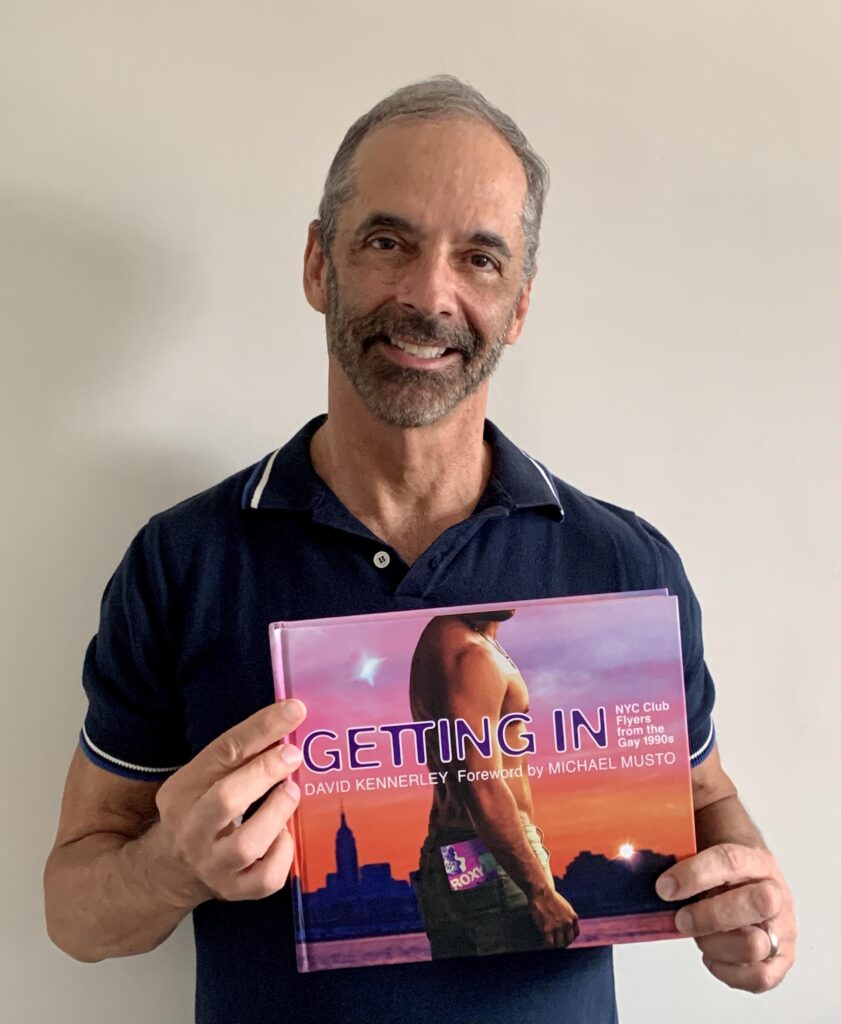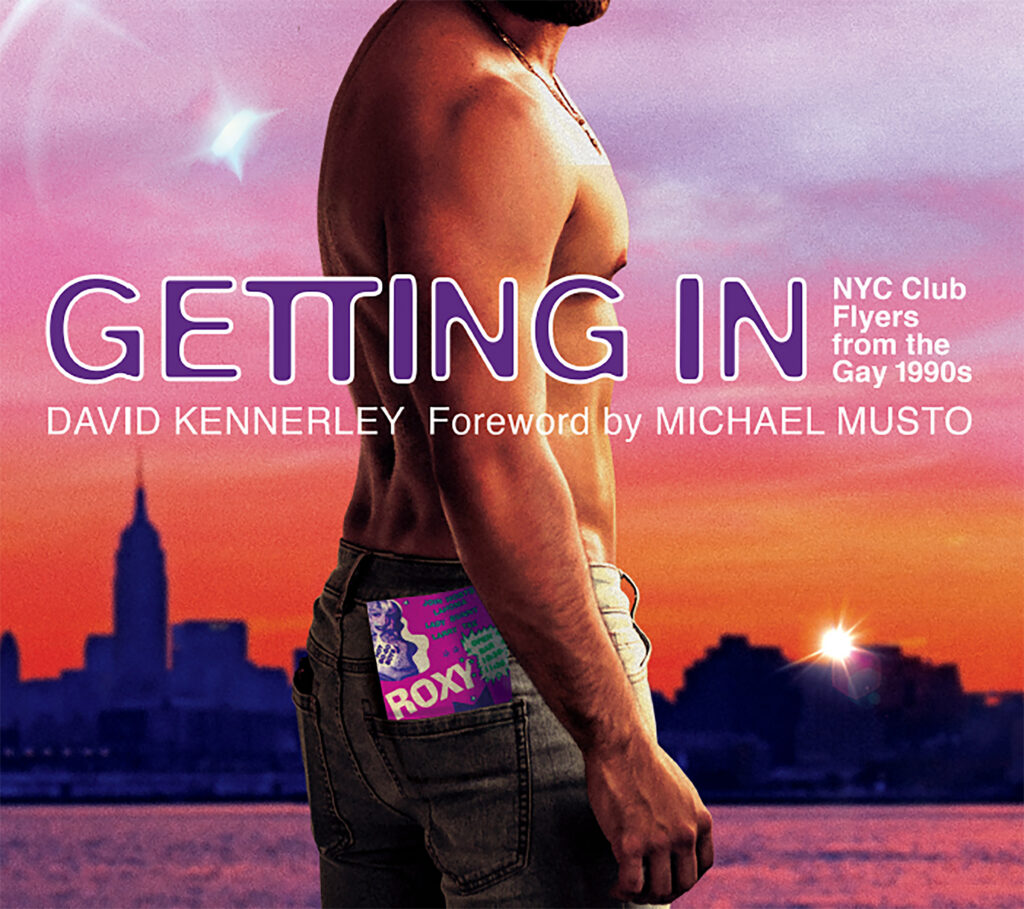A work of art, a statement, a tribute, a journey through history….Arts and entertainment journalist David Kennerley’s new book “GETTING IN: NYC Club Flyers from the Gay 1990s” is all of the above and more, and includes a riveting introduction by world renowned columnist, author, and everything else Michael Musto.

Artistically, it offers the exquisitely vibrant pictures of the flyers from the iconic LGBTQ clubs that thrived in the 90’s, including the Limelight, the Roxy, Twilo, the Copacabana, and others that might have been lost forever if not carefully saved by David through the years. The book takes you on a journey through the illuminated tapestry of the crudely macadamized cement streets of New York City, leading to the gateways of the club scene, where a multichromatic, sophisticated anarchy of dance, music, drag, club kids, and the fear of AIDS took place. “GETTING IN: NYC Club Flyers from the Gay 1990s” is set for release late August.
INTERVIEW
Hi, David. Congratulations on your book.
Thanks. It’s my first one. It’s taken me three years to do. So it’s kind of a big deal for me.
Well, it’s a coffee table book, right?
I use that term because it’s got lots of amazing photos and it’s hardcover and it’s substantial, but it’s really more than that because it’s also a history of gay clubs. It’s got timelines and a map that shows you where all the clubs were in the ‘90s. So it’s sort of a combination.
What inspired you to do this?
When I was in my late 20s, I started going clubbing in New York City, starting in 1990. I hadn’t come out yet. So I was still sort of bi-curious and trying to figure out my own way. And then I discovered the Roxy, which was a big gay club on West 18th Street. Big clubs were so unusual to me, because I had never really gone to any before, and I was fascinated when they would hand out these flyers. You know, for the big parties, the promoters would hand them out. And I was just like, “Why are people throwing these out?
You don’t like these really great pictures of these hot guys with their shirts off and drag queens and club kids?” I was like, “I’m saving these.” I just became obsessed with collecting them. I got on mailing lists. Some of the promoters have very extensive mailing lists. So I would go into different gay type bookstores and they always had stacks of the flyers. I kept them all. My friends kept on telling me, “You should be sharing this with other people.” So I decided to do a book.
Here’s my question. Do you still live in New York? Do you still go to the clubs in New York?
I still live in the West village. I lived in Chelsea before but now I’m in the West Village. I still go out occasionally, mostly to the smaller bars. But occasionally I will go out to some of the big dance parties in Brooklyn. But they don’t hand out the flyers anymore.
How did the atmosphere change from the ‘90s to now?
The way I see it, the ‘90s was a very particular time in LGBTQ history. AIDS was raging. The AIDS crisis obviously happened across the ‘80s, but then, in 1990, it was getting to a very critical point, where the cocktails and the drug treatments had not been available yet. So, if you got AIDS, you had a death sentence. So the clubs, in my opinion, became a refuge and a safe haven, as well as a community builder for the LGBTQ community, where you could go and be with people who were like you. Like I said, it was a safe space. They would hold parties to benefit AIDS service organizations such as GMHC and ACT UP. In the ‘90s, especially in the beginning, you could rarely go to a big gay club and not have it be a benefit for AIDS.

What prompted you to get Michael Musto to write your intro?
Well, to be honest, I interviewed him in the past when he came out with one of his books. I know he’s very articulate. And I would run into him in the theater, so we crossed paths. I know that he’s been around, not just in the ‘90s, but also with the ‘80s. I used to read his “La Dolce Musto” column in the Village Voice and I just thought he would be the perfect person to explain what that ever was about. So it started out as an interview for an article and it turned into a forward. Also, we just had lunch yesterday because he hadn’t seen the book yet, and I had just gotten the advance copy, and I was so excited, the first person I ran to was Michael Musto!
What do you hope will happen with your book, aside from the fact that you hope it sells a billion copies?
This really is a passion project. I am not sure how many copies are going to sell. It’s all first edition, but I am already planning a second edition. I am self publishing, so I wanted to be sure that the response was as favorable as it could be, and so far it has been.
I’m hoping it actually makes a contribution to queer history because, as you know, most of these flyers were just thrown out. I saw them as works of art. So I feel like the creators of these flyers have been neglected. I’m trying to shine a light not only on the amazing clubs from the era–which there’s not going to be those kind of clubs anymore in Manhattan because real estate has changed so much–but also, I just want to contribute to queer history and make sure that people understand that these clubs were not just places to have fun, that they were places that were really valuable to the LGBTQ community. So the short answer to your question is that I want to contribute to LGBTQ history.
How can people get your book?
Right now, they can pre-order at http://gettinginclubbook.com. It’s very easy to order and the actual book itself, which is being printed in Korea, is going to be shipped and it should be arriving at the end of August.
Will you be doing some book signings?
Yes, those are in the works. And I do have some verbal agreements with bookstores, but I don’t have anything in writing so I don’t want to announce that yet.
GettingInClubBook.com

